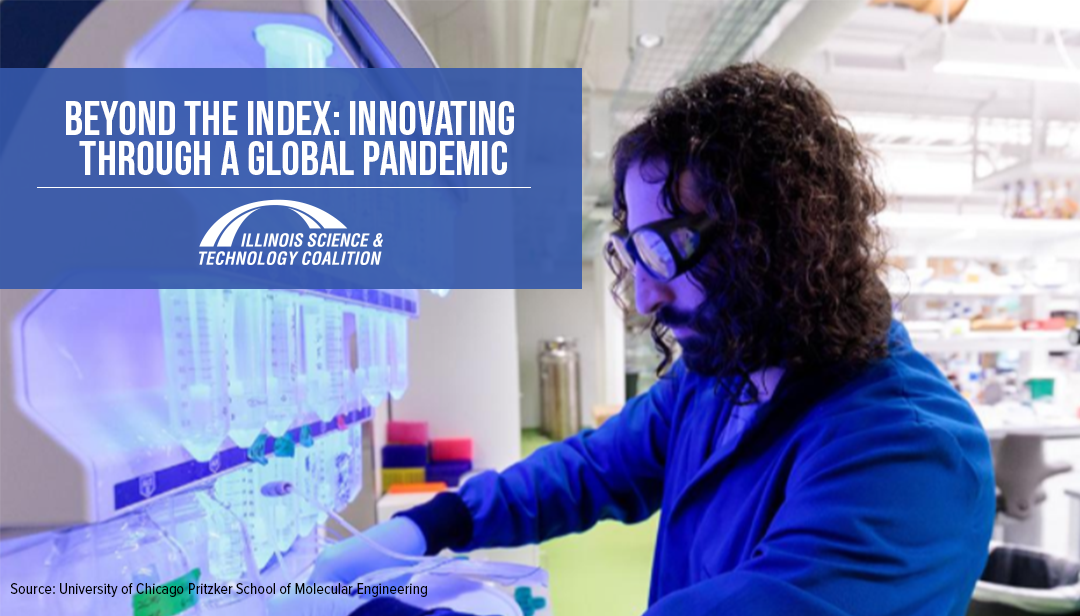Leveraging R&D collaborations to speedtrack Illinois’ economic recovery
By Matthew Bragg, Director, ISTC
Research & development (R&D) is the lifeblood of innovation. Illinois’ universities, businesses and federal labs all use R&D to create new technologies, products and services that create jobs and drive economic growth. Earlier this month, we released new data detailing R&D activity in the state through our Illinois Innovation Index.
Takeaways from the new data were mixed. R&D growth among Illinois businesses hasn’t kept up with the national average, but key industries like food and software are accelerating. Research funding at our universities hasn’t grown as quickly as in many peer states, but our researchers are efficiently turning fewer research dollars into more publications, patents and licensing income. Illinois’ two federal labs continue to be a bright spot for the state, contributing more than $1 billion in R&D activity each year.
Subscribe to get the Catalyst newsletter sent to your inbox.
However, these findings show the path the state was on before the global pandemic—complete R&D data for 2020 won’t be available until at least 2022. The question now is: How will the economic slowdown affect critical R&D activity as Illinois moves into a new decade?
Evidence suggests R&D within business will scale back in the wake of the pandemic, as is typical during economic downturns. Following the onset of the Great Recession in 2008, business R&D fell for two consecutive years nationally, before rebounding in 2011. Though more insulated from downturns by federal funding, university research activity also slowed in the state following the Great Recession.
Given the likelihood that R&D activity will be impacted by this unique pandemic, the state’s innovation community must look to create R&D collaborations between businesses and universities that can put the state on track to grow its economy and create strong jobs. These collaborations have been shown to boost R&D by leveraging the unique strengths of both businesses and universities. Businesses benefit from the expertise of highly qualified university researchers;1 insight from new technology and knowledge;2 and access to unique research infrastructure, including facilities and equipment. In return, universities benefit from additional funding, market insight and the creation of new IP and licensing income.3
Evidence suggests R&D within business will scale back in the wake of the pandemic, as is typical during economic downturns. Following the onset of the Great Recession in 2008, business R&D fell for two consecutive years nationally, before rebounding in 2011.
Fortunately, these important R&D collaborations are already taking shape. New large-scale R&D partnerships like the Chicago Quantum Exchange, Discovery Partners Institute, Illinois Innovation Network and Institute for Mathematical and Statistical Innovation are bringing together universities and businesses to grow the state’s capacity for innovation.
These large-scale collaborative partnerships are vital, and must be supported moving forward, but the state should also look to create more discrete partnerships that allow individual businesses to access the R&D resources of Illinois’ universities. ISTC’s Illinois Innovation Vouchers would do just that by incentivizing new R&D engagements between individual businesses and in-state academic research institutions.
Illinois Innovation Vouchers would be awarded to businesses to help offset the cost of an R&D engagement with an in-state university. For example, if an Illinois company is designing a new product and needs use of a university research lab, an innovation voucher could help cover a portion of that cost. Other examples include a business leveraging an engineer in residence; contracting with a university researcher to assist in the R&D process; or testing a new technology using university equipment—among many others. Collaborative R&D engagements created through the program would boost both business competitiveness and university research and commercialization activity, leading to new jobs and economic growth for the state.
These large-scale collaborative partnerships are vital, and must be supported moving forward, but the state should also look to create more discrete partnerships that allow individual businesses to access the R&D resources of Illinois’ universities.
2020 has presented innumerous challenges for economies across the globe, but it also presents an opportunity for Illinois’ innovation community to take actions that set the state up for success. As the state moves into a new decade, the ability of businesses and universities leverage their diverse strengths through collaborative R&D engagements will play a pivotal role in growing Illinois’ capacity for innovation and create strong jobs.
(1) Myoken, Y (2013). “The role of geographical proximity in university and industry collaboration: case study of Japanese companies in the UK”
(2) Barnes, T., Pashby, I., & Gibbons, A. (2002) “Effective university–industry interaction: a multi-case evaluation of collaborative R&D projects”
(3) Ankrah, S., AL-Tabbaa, O. (2015) “Universities–industry collaboration: A systematic review”

